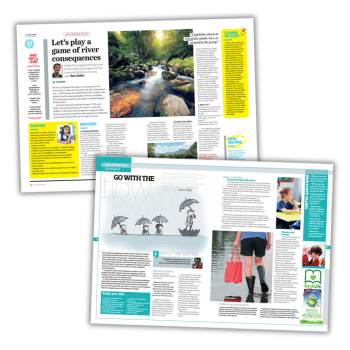Consequences rivers KS2 lesson plan
We have all played the game of ‘consequences’ at some time or other (he said, she said, the consequence was…). This first rivers KS2 lesson uses that framework to explore the physical features and human geography of rivers.
This includes how upstream activities can impact on what happens further down.
Activities have been pitched at ages 7-9 (Lower KS2), with extension ideas for older or more able children. They have been designed to support small group enquiry, but could be easily adapted as individual assessment tasks at the end of a unit on rivers.
Rivers KS2 learning objectives
- Use a simple framework to outline the key physical features of a river
- Use geographical language to describe a river’s features
- Explain how people use rivers
- Understand natural and human impacts on river systems
Ben Ballin is a primary geography consultant to the Geographical Association and a CPD associate for Shropshire LA. These activities were originally trialled with Shropshire teachers.
Flooding lesson plan
From a physical geography perspective, there is little more relevant and topical than learning about rivers and the importance of water.
There is often either too much water, which leads to flooding, or too little, which results in drought. When considered alongside issues such as extreme weather patterns and climate change, this means we are always looking for, and in need of, explanations.
If extreme weather is to be a part of our future, then we all need to start considering potential solutions.
Through the context of real world issues, children are able to develop their skills in problem-solving by engaging in hands-on activities. And these skills are going to be vital if they are to lead successful lives in our ever-changing world.
In order to take their first steps towards overcoming the challenges presented by flooding and drought, children need to develop a better understanding of the patterns and processes of rivers; the physical features and concepts of flow; the river as a system; and what happens when the component parts of the system are changed.
Rivers KS2 learning objectives
- Learn about the patterns and processes of a river and understand that a river is a system
- Understand what can change a river’s flow and how excess flow may cause flooding
- Recognise and understand the impact of flooding from both constructive and destructive perspectives
- Work collaboratively to come up with ideas to minimise the damage of floods
- Consider future scenarios and transform the negative to positive impacts
Tessa Willy is SL Geography Education PGCE (Primary) Programme Convenor at the Department of Education, Roehampton University.











